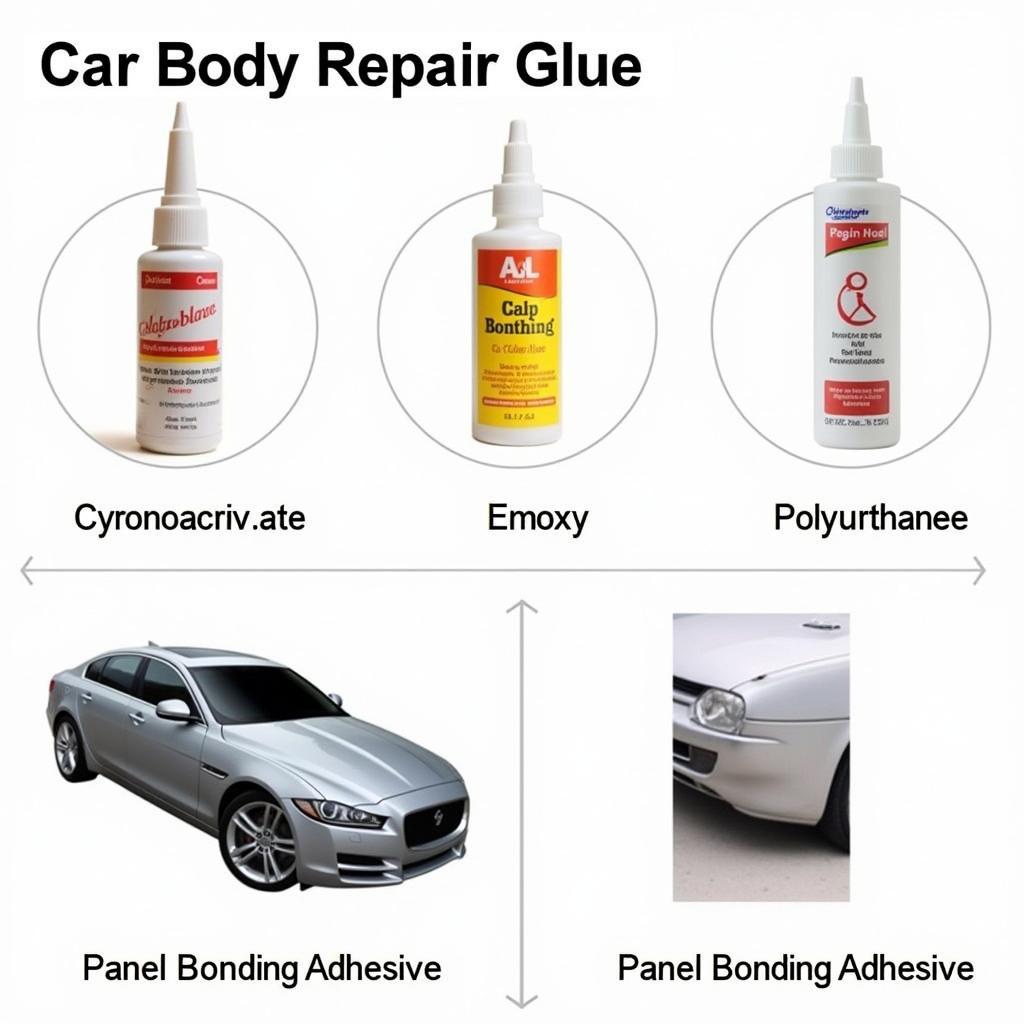Car body repair glue is a versatile and increasingly popular solution for fixing minor damage to your vehicle’s exterior. From small dents and cracks to plastic bumper repairs, understanding the different types of car body repair glue, their applications, and best practices can save you time and money. This guide will delve into everything you need to know about using car body repair glue effectively.
Choosing the right car body repair glue can be overwhelming. Are you repairing a plastic bumper, filling a dent in metal, or reattaching a trim piece? Each task demands a specific adhesive. This article will help you navigate the options and achieve professional-looking results. For specific repairs like dent removal on body lines, you might find specialized tools beneficial like those mentioned in our guide on car body line dent repair.
Types of Car Body Repair Glue
Several types of car body repair glues cater to different materials and repair scenarios. Understanding these distinctions is crucial for a successful repair.
Cyanoacrylate Adhesives (Super Glue)
Known for its fast-acting bonding properties, cyanoacrylate is excellent for small, quick fixes on plastic and metal. It’s ideal for reattaching small trim pieces or securing minor cracks.
Epoxy Adhesives
Epoxy offers a strong and durable bond, making it suitable for larger repairs and filling gaps. It’s often used for structural repairs on plastic bumpers and other components. Epoxy adhesives come in two parts that need to be mixed before application.
Polyurethane Adhesives
Polyurethane adhesives are known for their flexibility and ability to withstand vibration. This makes them perfect for bonding dissimilar materials, such as plastic to metal, and areas prone to movement.
Panel Bonding Adhesive
Specifically designed for bonding body panels, this type of adhesive creates a strong, structural bond. It requires precise application and proper surface preparation for optimal results.
How to Use Car Body Repair Glue Effectively
Proper surface preparation is critical for achieving a strong and lasting bond. Before applying any adhesive, ensure the area is clean, dry, and free of grease, dirt, and rust. Lightly sanding the area can improve adhesion.
Apply the adhesive according to the manufacturer’s instructions. Some adhesives require clamping or specific curing times. Ensure proper ventilation during application and curing. A car body dent repair kit often contains essential tools and materials for a seamless repair process.
After the glue has cured, sand down any excess adhesive and prime and paint the repaired area for a seamless finish. You can find a suitable repair kit at many retailers, including Halfords, as detailed in our guide on car body repair kit halfords.
Choosing the Right Glue for the Job
What type of car body repair glue should I use for plastic?
For plastic repairs, cyanoacrylate (super glue) is suitable for small cracks and reattachments. Epoxy or polyurethane adhesives are better choices for larger repairs or bonding dissimilar materials.
How do I prepare the surface before applying car body repair glue?
Clean the area thoroughly with a degreaser and ensure it is dry and free of rust. Light sanding can improve adhesion.
Can car body repair glue be used on metal?
Yes, certain types of car body repair glue, such as epoxy and panel bonding adhesive, are specifically designed for metal repairs.
Expert Insights
“Using the correct car body repair glue is essential for a successful and lasting repair,” says automotive expert, David Miller, from Automotive Repair Solutions. “Always choose the appropriate adhesive for the specific material and damage type.”
“Proper surface preparation is key for achieving optimal adhesion,” adds Sarah Johnson, a seasoned mechanic with over 20 years of experience. “A clean, dry, and lightly sanded surface will ensure a strong and durable bond.”
Benefits of Using Car Body Repair Glue
Car body repair glue offers several advantages:
- Cost-effective: Often less expensive than traditional body shop repairs.
- Time-saving: Many repairs can be completed quickly and easily.
- DIY-friendly: Suitable for various skill levels with proper guidance.
- Versatile: Can be used on a variety of materials and damage types.
For complex repairs, specialized tools like a T-puller might be necessary, which you can learn more about in our article on car body dent repair tool kit t puller. You can also explore options for car body repair tool hire if you prefer not to purchase these tools.
Conclusion
Car body repair glue is a valuable tool for addressing minor damage to your vehicle’s exterior. Selecting the correct type of glue and following proper application techniques will ensure a strong, durable, and aesthetically pleasing repair. By understanding the various types of adhesives available and their specific applications, you can achieve professional-looking results while saving time and money.
FAQ
- What is the strongest car body repair glue?
- How long does car body repair glue take to dry?
- Can I paint over car body repair glue?
- Is car body repair glue waterproof?
- What are the common mistakes to avoid when using car body repair glue?
- How much does car body repair glue cost?
- Where can I buy car body repair glue?
Need support? Contact us via WhatsApp: +1(641)206-8880, Email: [email protected]. We have a 24/7 customer support team.


